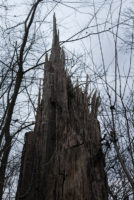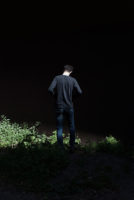Jonas Feige was picked by Melissa Catanese as one of the winners of the 2015 Conscientious Portfolio Competition. Melissa wrote: “I chose this work for its open-ended narrative. Time feels as though it’s stuck somewhere between the past and present. The sequence is thoughtful and the implied metaphors left me curious as to what may have happened within this constructed world. The sequence quietly begins with an entrance through the dark shrubs at night. The first character feels as though he’s a ghost from the past, juxtaposed by a discarded bottle on the ground. Condensation shines in the bottle and makes me think of the exoskeleton of a cockroach, recollecting Kafka’s well-known novella, The Metamorphosis. The viewer is led through both a stark interior world, and a minimally framed natural world – the base of a cliff with a shallow, yet ominous cave; the rotting trunk of a tree read from the cockroaches perspective; and finally ending abruptly at a corrugated metal fence where the flash bounces you backwards to the beginning again.” I spoke with Jonas to learn more about his background and work.
Jörg Colberg: Can you talk about your background? Who are you as a photographer, what are your main interests and/or motivations?
Jonas Feige: I like photography because of its inherent contradiction. No matter how abstract or staged a photograph might be, since it is taken with a camera it will always be assumed to at least partially representing reality. But there is so much that goes into making (and publishing) a photograph that it can never be more than an interpretation.
And that’s a great paradox, because it opens up a lot of creative space and the possibility to work with it. It allows us to use photographs not only as documentation but as a means of expression. And it enables the photographer to tell fictional stories or to talk about the future, rather than the past – all that while maintaining the idea that what you see is somehow real – something a painting could not do.
I aim to take photographs that are very clearly taken from the real world and that can be combined into open-ended narratives in order to talk about things you could not express otherwise. I like when things are a little obscure, cryptic and not easily solvable.



JC: Night on the Sun, you say in your short intro to the work, is a phrase “that hints at our inexplicable, arguably meaningless existence.” Can you talk about what motivated you to try to photograph around the idea? Why bother making pictures when it’s all meaningless anyway?
JF: During my studies I actually asked myself that very often. You are of course constantly challenged to come up with ideas for projects that you could realize within a semester or two. I often had a hard time pinning down what I was looking for. Mostly because that question of meaninglessness kept nagging me, and after a while I noticed that it would also find its way into my photography, my motives and aesthetic.
I think the starting point for the series was reading a book that actually tries to answer that exact question. In The Myth of Sisyphus, Albert Camus talks about the ultimate absurdity of life: If there is no God, no definite answers, and if we are all going to die anyway, what is the point of living? He rejects the idea of suicide, instead saying that we have to accept but also revolt against that contradiction. One way of doing that is by making art, by being a creator and thereby giving life a meaning of your own.
Now this is all very theoretical, and I don’t claim to be a philosopher, but reading that certainly motivated me to ask a different question. So instead of „What are you going to photograph this semester?” it would be „Why photograph at all?” and my pictures would be the answer to that question. It sounds a little sinister but it is actually the opposite. It freed me up and allowed me to not frantically chase after the pictures but to just let them come to me, as cheesy as that sounds.
JC: How would you go photographing then? Wander, and find pictures? And how would you make sense of it all – what the bigger story might be, how to edit…?
JF: Wandering and finding pictures is certainly a big part of it, but it sounds a little too coincidental. For a lot of the motives I had a general idea of what I wanted, and I then figured out where I might go in order to get it.
For example, after a while I knew that I wanted to have some images that talk about traces of mankind in nature, which led to me visiting a salt mine. I wasn’t interested in showing the salt mine as it is, but I assumed that the location might provide me with some unique motives. I don’t usually have an exact image in my head before photographing and when I do, most of the times they end up not being as strong as the ones that just jump at me, surprise me.
This also means collecting a lot of images and constantly editing right from the start, figuring out where your photographs take you and then trying to follow up on that. Pinning down what exactly it is that makes one image stronger than the other and finding common ground between them can be really difficult. That’s probably where most of the actual work lies and I am glad that I had many fellow photographers that I was able to ask for outside perspectives.
I probably changed direction a couple of times throughout the project, but it was very important for me to keep things open right until the end. I always think that when you decide on a concept too early on or when you set up too many rules for yourself, you end up just illustrating preconceived ideas instead of actually discovering something new.



JC: I’m curious about your predominant use of a portrait frame for most of the photographs. It might really not be a very relevant question, but still the framing makes for an interesting dynamic in many of the pictures. Can you talk about that?
JF: I sometimes wonder about it myself, and I don’t think I ever made a conscious decision to use it as much as I do. But especially with Nacht auf der Sonne [Night on the Sun] it does enhance the cryptic nature of the motives. With the portrait frame you can really isolate your subject, take it out of context and elevate its importance. It might have to do with the fact that we read things from left to right and that the portrait frame basically cuts off the surroundings, leaving you with very little information about where you are and what you are looking at. I think this can become especially confusing (in a good way!) when you hint at an overall narrative.
JC: Given you have also made books, can you talk about the role they play for you?
JF: The two books I have made have actually first and foremost been ways of finding out where the work is headed. I started making dummies very early in the process and that allowed me to edit and thereby to find out what I was going for right from the start, in parallel to the actual photographing.
Another reason for the books was to steer things in the right direction. As I said, I like to leave a lot of room for interpretation in my work, and I do not want the viewer to accept a predetermined idea. But that does not mean that you can just let go of your images, an open-ended narrative might even be more difficult to tell than a closed one. Online, for example, you don’t have a lot of control over what is going to happen to your photographs, the context or the edit in which they will be presented. A book provides you with that control and really lets you fine-tune your vision.
I only self-published the two books I have made in very small numbers, but it is of course a great experience to have it transformed the pictures into something physical, something that can easily be shared.
